As savvy and suspicious digital natives, Generation Z can see right through most brands’ marketing strategies. They won’t reward inept efforts with their hard-saved dollars — and they’ve got a lot of dollars.
Unlike the famously cash-strapped Millennials, Gen Z is entering the marketplace with massive spending power: about $360 billion in disposable income. That’s a huge new demographic for your eCommerce business to take advantage of, but you’ll need the right approach to do so successfully.
At Inflow, this isn’t the first time we’ve helped our clients pivot focus to target new cohorts of shoppers online. With our decades of experience, we have learned to read the currents of change and spot profitable opportunities.
To that end, we’re already helping our clients successfully target Gen Z shoppers — and, in this blog, we’ll help you understand some of the strategies we’ve found to work best when targeting this unique demographic.
Who Is Gen Z — and Why Are They So Different?
Generation Z, sometimes called “Zoomers,” is defined as those born from the mid-1990s to the early 2010s.
Since Generation X, social generations have been somewhat standardized at 15 years. Therefore, the most common definition of Generation Z includes those born from 1997 to 2012.
At 20.67% of the US population, Gen Z is slightly smaller than the Millennial Generation (21.75%) and slightly larger than Gen X (19.83%). (Note: Statistics that show that Gen Z is significantly larger than the Millennial Generation usually define the age group as “born 1997 and later.”)
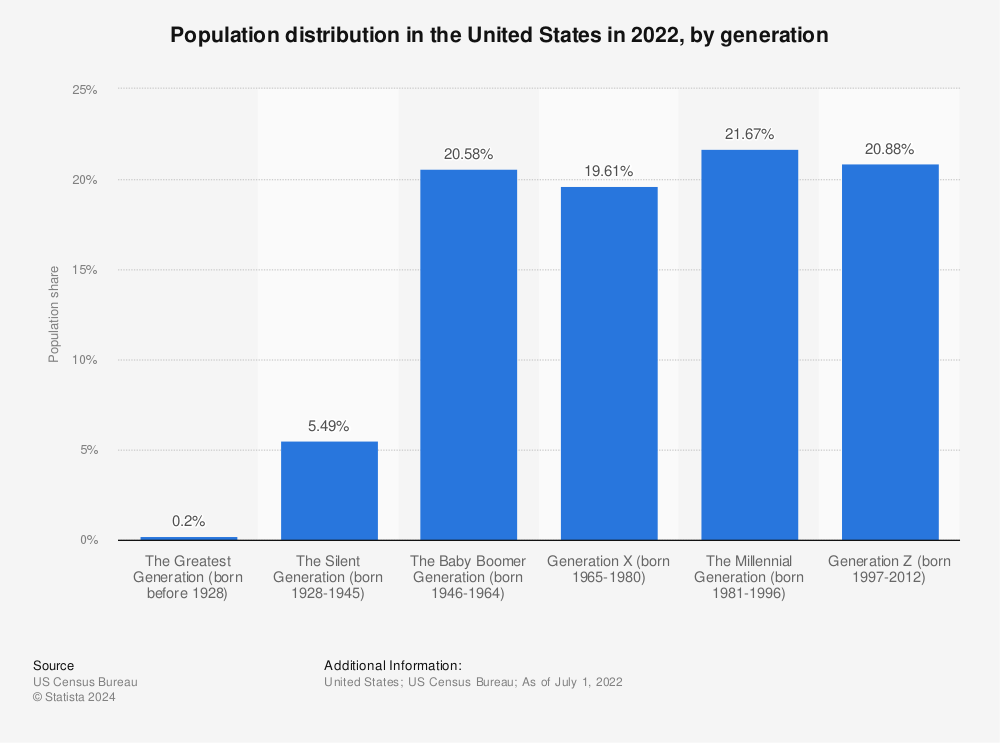
Find more statistics at Statista
Gen Z is still on the rise in terms of their income and their spending, but even so, there are already some clear spending patterns that differentiate them from Millennials.
Overall, Gen Z accounted for about 5% of all spending in 2020, but that’s expected to increase to 17% by 2030.
Together with Millennials, they will account for nearly half (48%) of all spending by the start of the next decade.
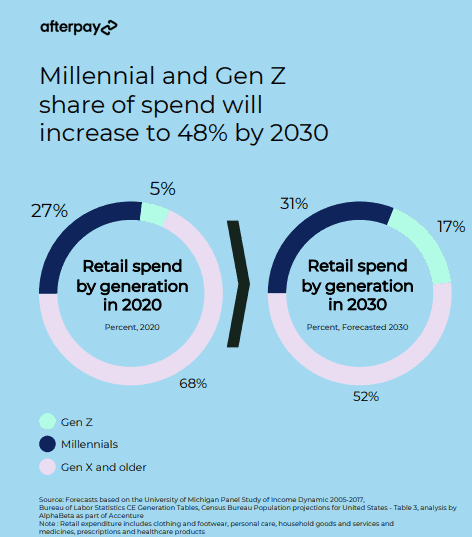
On a Quest for Truth
Gen Z’s dedication to education is partly linked to their need for financial stability. However, it also goes along with the characterization by McKinsey & Company that they are the “True Gen“: a generation defined by its quest for truths.
Although this report is a few years old now — and, significantly, published pre-pandemic — many of its insights have been borne out in subsequent years.
The McKinsey report highlights four basic behaviors that come from Gen Z’s particular search for truth:
- Undefined ID: “Don’t define yourself in only one way.”
- Communaholic: “Be radically inclusive.”
- Dialoguer: “Have fewer confrontations and more dialogue.”
- Realist: “Live life pragmatically.”
As we’ll see, this combination of values can make marketing to Gen Z challenging. Not only might you need more interactions and data points to market to an individual, but your marketing to that individual might also be impacted by your marketing to other individuals.
The unequaled racial, ethnic, and gender diversity of Gen Z is more than a simple demographic fact: It’s a value they’ve embraced.
There’s a great silver lining here. Although Gen Z is prepared to boycott your brand if they don’t like your values, they would much rather work with you to help your brand do better and be better.
8 Important Generation Z Shopping Habits to Consider
To build successful strategies that win over Gen Z shoppers, you first have to understand how they shop.
Here are some key Gen Z shopping habits to keep in mind before we start talking strategy.
1. They generally spend less.
Generation Z seems to have more frugal spending habits than Millennials, who had a (probably unearned) reputation as spendthrifts. In particular, they are less likely to want to buy on credit.
This is likely related to their rejection of traditional credit in favor of buy now, pay later (BNPL) arrangements. By mid-2021, credit card spending only grew by 8% from pre-pandemic levels, while BNPL grew by 230%. For Gen Z, BNPL spending grew by 330%.
As the first generation to grow up with the proliferation of Amazon, Gen Z has never known a world where they can’t price shop with their phone in the palm of their hand — meaning they’re continually on the lookout for a bargain and other benefits like free shipping and free returns.
2. They are belief-driven shoppers.
Generation Z shoppers see the marketplace as a way to influence the world with their dollar.
They want to know a retailer’s values and admit to boycotting brands with values they don’t like. However, they are prepared to pay more for sustainable products.
3. They want to avoid the digital “big boxes.”
Given their commitment to values, it’s not surprising that Gen Z is more likely to avoid shopping on Amazon and other big-box online marketplaces than older generations.
Afterpay data shows that Gen Z is spending more money at small businesses than other generations. This could present opportunities for smaller brands to win over new shoppers.
4. They shop with their phones.
As digital natives, Gen Z has grown up with their phones in their hands. This means they feel comfortable using their mobile devices for everything, including shopping.
Being mobile-friendly is not so much a strategy for marketing to Gen Z as a prerequisite.
5. They shop via social media.
Social media shopping is growing in popularity. About two-thirds of Gen Z shoppers purchase products via social media, a number that is expected to continue increasing.
Even if they’re not buying on social media, they’re still going there to find inspiration. About 80% of Gen Z shoppers say social media influences what they buy.
6. They are omnichannel shoppers.
Although Gen Z loves to shop via social media, they also prefer a diverse array of shopping experiences.
They enjoy shopping in person, as well as on a brand’s website and via a brand’s app — but many say they will buy from the most convenient source and/or the one with the best price.
7. They expect personalized shopping.
Gen Z has grown up in a world where retailers can offer personalized recommendations and the convenience of apps and websites that anticipate their online shopping needs.
This is their normal — and, if a brand doesn’t deliver, it leads to a substandard experience.
8. They are impatient.
Another side effect of being digital natives? Gen Z consumers expect everything to be fast.
They have little patience for slow-loading websites and apps, nor do they want to wait for the products they order.
16 Gen Z Marketing Strategies for Your eCommerce Brand to Use
So, how do you turn this understanding of who Gen Z is and how they shop into effective marketing?
Below, we’ll explain some of the strategies we’ve developed, based on our nearly 20 years of working with eCommerce brands.
Remember: Not all of these strategies will work for all brands. It’s important to test approaches and monitor results carefully to find the ones that work best for you.
If you want help honing your Gen Z marketing strategy, you can contact our experts for a free, personalized proposal for your online store. We’ve helped several clients pivot their marketing to attract Gen Z clients, and we can quickly design, test, and implement effective strategies for your brand, too.
Focus on Brand Values, Sustainability, & Ethics
As we’ve noted above, Gen Z shoppers believe their dollars should support brands that share their values. A company’s social responsibility reputation either influences or highly influences purchase behavior for 55% of Gen Z shoppers.
If you want to reach these consumers, you need to demonstrate your commitment to good values and ethical practices.
Communicate authentically.
Sharing your values doesn’t mean simply saying what you think Gen Z shoppers want to hear.
Growing up in a “post-truth” era made Gen Z suspicious of brands. They’re prepared to do the research necessary to know when a brand is truly committed to the causes they espouse.
If you’re not committed, they don’t have time for your noise. About a third of Gen Zers report unfollowing, hiding, or blocking at least one brand on social media every week.
Make sustainability commitment clear.
Gen Z cares about your commitment to sustainability. If you want to win them over, make it clear that you are doing what you can to reduce your carbon footprint and generally be a good steward of the world’s resources.
Remember, there’s a plus side to this: Gen Zers will pay more for sustainable products.
Demonstrate radical inclusivity.
Gen Z has embraced its identity as a diverse community. They perceive attacks on some of their community members as attacks on them all, and they have no tolerance for it.
In the McKinsey report, 76-81% of Gen Zers said they would stop buying brands with campaigns they perceive as homophobic, racist, or “macho.”
In addition to their ethnic diversity, Gen Z is more diverse in their gender identity and more likely to be allies to those who don’t align on the binary gender spectrum. They feel that it’s important for brands to welcome shoppers who don’t conform to traditional gender norms.
This is most important for fashion brands, where Gen Z’s buying power makes the biggest impact, but all retailers should ask whether their products benefit from gendering.
Build, Reward, and Maintain Brand Loyalty
Perhaps because Gen Zers work so hard to interrogate the authenticity of brands they shop and interact with, they can be fiercely loyal to the brands they support.
They are prepared to come back to buy from you again and again, which can have tremendous benefits for your eCommerce brand.
To take advantage of that tendency, check out our complete guide to maintaining customer loyalty via social media.
Customize the Shopping Experience
Loyal customers give you a lot of information. You need to use this information to personalize the eCommerce experience of your Gen Z shoppers.
Give them personalized recommendations, an easy checkout experience, and, of course, bargains.
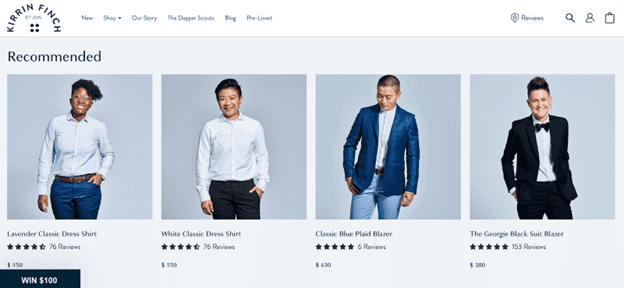
Speed Up Your Site
Nobody likes a site that’s slow to load, and Gen Z has earned their Zoomer moniker in part because they’re so impatient with subpar internet experiences.
Site speed is a great thing to invest in because it not only helps you target Gen Z, but also improves your customer experience for all demographics — and helps your rankings in Google’s search results.
Offer Quick Delivery
Gen Z’s impatience shows here. They want their packages quickly, and they’re not alone.
The number one thing that online shoppers would change about the customer experience is getting faster delivery. Free and fast delivery is a great loyalty perk (and one that we encourage every brand price out in its customer service offerings).
Use SMS (Text Message) Marketing
Phones are more than a tool for most Gen Zers. Their phones are an extension of themselves. It’s part of the way they think, and it shapes many of their interactions with the world.
As a result, SMS marketing is an effective way to reach them. These shoppers will always have their phones, and this direct line of communication has a very high open rate.
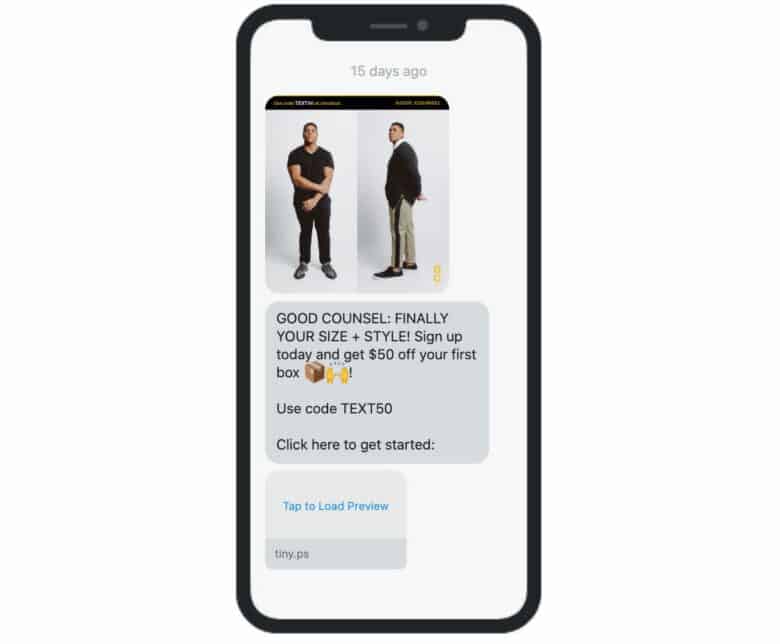
Be careful not to overdo it, though, as they will block you without hesitation if you’re becoming a nuisance.
Offer Buy Now, Pay Later Options
As we’ve mentioned before, Gen Z may be suspicious of traditional credit, but they love BNPL options.
There are many factors for this (ease of use on mobile, lower bar for acceptance, “cool factor,” etc.), but the key factor to keep in mind is that offering these payment methods is critical to winning over Gen Z shoppers.
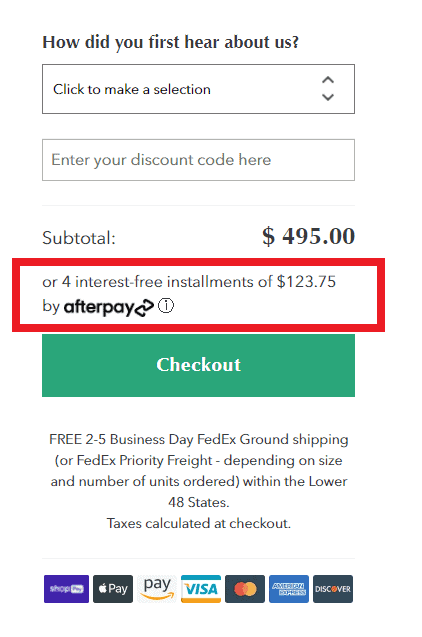
Find the best application for your business in our guide to using BNPL to improve sales.
Involve Influencers & Social Media
Gen Z has never known a world without social media. It’s natural for Zoomers to use it, but they have a complex relationship with it, and some of the ways they interact with it may seem strange to older users.
Here are some recommendations for making the most of this powerful marketing channel when it comes to this generation of shoppers.
Expand your social media channels.
If you want to reach Gen Z shoppers via social media, then you need to be where they are.
While some Gen Z shoppers can be found on traditional social media like Facebook and Instagram, they have spread out through the social media ecosystem. You’re more likely to reach Gen Z via channels like TikTok, Reddit, and YouTube.

New to TikTok? Check out our guide to TikTok for eCommerce.
For many Zoomers, online gaming is the preferred “social media” channel and should not be neglected. People make more purchases via video games than they do on brand websites and brand apps. In fact, 21% of consumers have made purchases through video games, and 42% say they like seeing their favorite brands represented in games.
Use influencers authentically.
Following influencers is part of the social media experience for Gen Z. About three-quarters say they follow influencers, and one-quarter say they follow many influencers.
These influencers often hold sway over Gen Z’s purchasing decisions, so it’s worthwhile for your brand to invest in influencer marketing.
However, there’s a peril here. You have to make sure that the influencers you’re working with have a reputation for authenticity and that your interactions with them maintain this authenticity.
To Gen Z, being authentic is an influencer’s most important attribute. When working with influencers, do substantial research to ensure you’re working with the right creators for your demographic, and be open to influencers’ recommendations on how your product can fit seamlessly within their existing brand.

Invite Gen Z creators to be partners.
The biggest difference between the internet and traditional media is that the internet is interactive. Gen Z has internalized this idea, and they want to actively partner with your brand by:
- Reviewing your product
- Participating in an online game
- Creating digital content for you
- Attending an event you sponsor
- Submitting ideas for product design
This makes them great sources for user-generated content (UGC), but you can go beyond this to really ship Gen Z shoppers with your brand. Invite people for interviews on your brand channel or agree to interviews on fans’ podcasts.
You might not have the resources to design games and sponsor events, but you can catch some of that energy by using hashtags and challenges to get fans excited and engaged in your brand story.
Create unique personas for social media channels.
If you really want to engage Gen Z shoppers on social media, it’s important to develop unique content for each channel. Partly, this is a way to avoid sounding repetitive.
Gen Z shoppers spend a lot of time on social media, and they don’t want to keep coming across the same boring messages from you. All social media channels are different, and you don’t want to be caught using your Facebook voice on TikTok. Just as it’s important to code-switch when you speak to different audiences in person, your brand needs to code-switch between social media channels, too.
Of course, make sure that your social media personas still reflect your brand’s values even when speaking with different voices.
Don’t Forget About Video
Gen Z aren’t just digital natives; they’ve grown up in the era of high-speed internet that made video streaming ubiquitous.
Vine is Gen Z’s MySpace: a short-lived social media platform that, because of its exposure during formative years, had an outsized impact on their developing relationship with online media.
So, it’s not surprising that Gen Z would so thoroughly embrace video content.
Nothing online influences Gen Z’s buying habits more than TikTok videos. They create, curate, and consume countless hours of YouTube videos. They even watch more hours of video training content on LinkedIn than any other generation.
Whatever you want to say to them, you need to learn to say it in a video.
When starting from scratch, it can be hard to pin down your eCommerce video strategy. You don’t have to produce high-quality videos, but they should be authentic, relatable, and on-trend.
Above all, they have to be entertaining.
@earthkind.living ♬ original sound – EarthKind
If you’re having trouble getting video right, consider inviting some fans to do it for you (see our notes about influencers and partners above). But don’t just use their UGC; learn from it, and create in-house content that reflects the tone in which Gen Z speaks to you and itself.
Building Your Gen Z eCommerce Marketing Strategy
Gen Z’s influence in the marketplace is growing rapidly. In the next few years, they’ll be contributing a significant share of all spending in the market, and soon after that they’ll be the biggest consumers.
Understanding their shopping habits now can help you design an effective marketing strategy for the years to come.
Above all, remember to be ethical and authentic. If you’re not, they’ll find out, and they’ll block and boycott you, while telling their friends to do the same.
We know that transitioning your marketing efforts can be time-consuming and expensive. Having help from someone who has experience making this type of transition can lead to a shorter learning curve — so your business can enjoy greater success faster.
If you’re ready to create an eCommerce marketing strategy that attracts and converts your Generation Z shoppers, don’t hesitate to contact our team today for a free, personalized proposal for your online store.










0 Comments